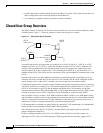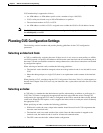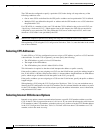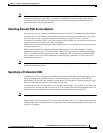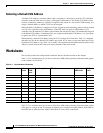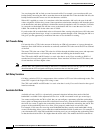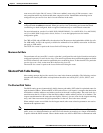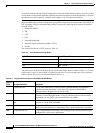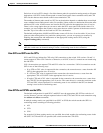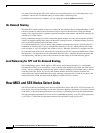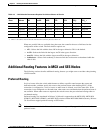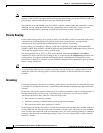
4-2
Cisco PNNI Network Planning Guide for MGX and SES Products, Release 5
Part Number OL-3847-01 Rev. D0, April, 2004
Chapter 4 Planning Intermediate Route Selection
How MGX and SES Nodes Select Routes
You can change the AW on links to control network traffic. For example, you can reduce traffic on a
backup link by increasing the AW to more than that on the desirable link. If the desirable link fails, the
backup link becomes the lowest cost link and becomes available.
When AW is applied to a route, it is sometimes called the cumulative AW and is the sum of the AW
values assigned to all links along a route. Some operations calculate the cumulative AW from the source
to the destination, and other operations calculate the round trip cumulative AW. For example, if all links
in a network use the default link AW, the source to destination AW for a route that uses two links is
10080. The round trip AW for the same route is 20160.
If you leave the AW set to the default value on all network links, routing using the lowest AW is the same
as routing using the fewest hops. A hop is a connection segment through a node. Changing the AW on a
link gives you the opportunity to make that link more or less desirable for routing.
Cell Transfer Delay
Cell transfer delay (CTD) is the measure of the delay an ATM cell encounters as it passes through an
interface. Since each link has an interface at each end, each link CTD is the sum of the CTD at each end
of the link.
The route CTD is the sum of the CTD values for all links through which the route passes and represents
the time interval between a cell exiting the source node and entering the destination node.
The CTD used in MGX and SES nodes is a static value that is set by Cisco according to PNNI 1.0
standard and is based on the speed of the interface. Faster interfaces will have lower CTD values, and
slower interfaces will have higher values.
Note Because the CTD is defined according to the PNNI 1.0 standard, the CTD for any specific link speed
should match the CTD assigned to third-party interfaces that use that link speed.
Cell Delay Variation
Cell delay variation (CDV) is a measurement of the variation in CTD over links and through nodes. The
route CDV is equal to the largest CDV along a route.
The CDV used in MGX and SES nodes is a static value that is set by Cisco and is based on the type of
interface and node.
Available Cell Rate
Available cell rate (AvCR) is a dynamically generated value that indicates how much of the link
bandwidth is available for the requested service class. AvCR is measured in cells per second (cps).
You cannot configure the AvCR for a link, but you can configure a parameter called the overbooking
factor, which can change how the AvCR is advertised for new calls. After the PNNI controller calculates
the AvCR for a route, it applies the overbooking factor to the AvCR before advertising the AvCR. The
purpose of the overbooking factor is to allow you to purposely under book or over book a link.
For example, if link users are reserving more bandwidth than they actually need, bandwidth is being
wasted. Overbooking allows you to make the wasted bandwidth available to other users. For example, if
you estimate that 30% of the link bandwidth is not being used, you can configure the overbooking factor
so that the advertised AvCR is 30% higher than the actual value. This enables the PNNI controller to



